The last bottleneck on the line between Jefferson City and St. Louis was removed this month when workers finished the 1,200-foot long Osage River rail bridge.
On Monday, dozens of construction workers, governmental officials, rail company executives and a few political dignitaries stood in the cold in Osage City to celebrate the bridge's completion. The project was a public-private partnership between government and Union Pacific; the bridge cost $28 million to build - about $7 million under original budget estimates.
Comprised of 2,200 tons of steel, the bridge was built by OCCI, Inc., a contracting company based in Fulton.
OCCI Project Manager Tim Schmidt said his "proudest moment" came on Nov. 14 when two trains - heading in opposite directions - met on the spans and safely passed one another without incident. "We took a picture," he said.
He noted Mother Nature - which sent deluges last May, causing significant flooding on the Osage - was one of the job's biggest foes. "Anytime you have a railroad project of this nature, you have to be prepared to deal with that," he said with a shrug.
The new bridge is expected to boost the efficiency of train operations and improve the on-time performance for both freight trains and the Amtrak Missouri River Runner that travels between Kansas City and St. Louis. The stretch handles about 60 freight trains and four passenger trains daily.
Located east of Jefferson City, the bridge removes a bottleneck created as two tracks would funnel into one single track to cross the Osage River before reconnecting again to a double main-line track. With the completion of this new bridge, the corridor between St. Louis and Jefferson City now consists entirely of "double tracks."
Ken Menges, director of the union that represents rail workers, was delighted on Monday.
"Now they can run trains constantly," he explained. "It increases productivity tremendously."
Menges said freight trains no longer will have to wait in Jefferson City for Amtrak passenger trains to move on by.
"The less time we're out here, the more time we get to spend with our families," Menges said, noting that Union Pacific workers are paid a per-trip - not a per-hour - rate. "This is great for us."
According to Michelle Teel, multi-modal director for the Missouri Department of Transportation, 90 percent of the Missouri River Runner trains arrived on time or ahead of schedule in fiscal year 2013, compared with 64 percent in 2008, largely due to rail improvements made west of Jefferson City. She added Amtrak ridership has increased for six consecutive years to nearly 200,000 passengers.
The bridge was funded mostly by stimulus grants from the 2009 American Recovery and Reinvestment Act. Union Pacific provided the remainder of the project cost - about $6 million to the partnership.
Workers not only constructed the new 1,200-foot span across the river, they also extended the existing bridge across the river by 30 to 40 feet.
Joseph Szabo, administrator with the Federal Railroad Administration, said: "It's great when we can come out and complete a project that is ahead of schedule and under budget."
Szabo said in the coming decades the U.S. transportation system will need to move an additional 100 million Americans and 4 billion tons of freight.
"This will put a tremendous strain on our already strained transportation systems that are stretched to their limit," he said. "Our economic success is going to depend largely on how well we respond to this transportation challenge."
Szabo also noted the new railroad bridge also advanced the Midwest Regional Rail Initiative. "A vision Missouri shares with eight other states to connect the Midwest's 40 largest cities with high-performance passenger rail," he noted. "It's time to commit to this higher-performing rail system that our country needs and our rail passengers deserve."
Szabo called for a "reliable funding stream" that would put rail travel "on par with other modes."
Ted Kettlewell, OCCI vice president, prompted the crowd to chuckle when he said: "We are very, very happy to spend anyone's $28 million."
He noted, while MoDOT is a valuable client to OCCI, most of the company's work happens elsewhere in the nation - from New York to the Gulf of Mexico. "This project has been a great chance for the OCCI family to build a project within the state of Missouri," he added.
OCCI also built pedestrian walkway over the Missouri River in Jefferson City - another cooperative project, he noted.
"More and more in our industry we are seeing that it takes cooperative funding and creative engineering" to get projects accomplished, he said.
He noted that railroad work and this type of bridge construction "is not for everybody."
"It's a tough industry," he said. "I'm here to celebrate those men and women who were on the ground and who actually get these jobs built and are thus able to provide for their families and enjoy what they do for a living. These are great people who work for us, and (they are) some of the best in the industry."
He noted the people who built the bridge are all Missouri residents.
"This is a Missouri job, built by Missouri residents, for the state of Missouri," he said. "It doesn't get any better than that. Thanks again, Union Pacific and MoDOT, for giving us the opportunity."

